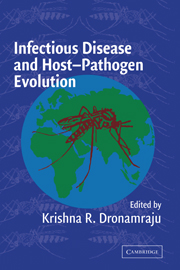Book contents
- Frontmatter
- Contents
- List of Contributors
- Introduction
- PART ONE J. B. S. HALDANE
- PART TWO MALARIAL PARASITES
- PART THREE OTHER PARASITES
- 7 Influenza Evolution
- 8 Free-Living to Freewheeling: The Evolution of Vibrio cholerae from Innocence to Infamy
- 9 Evolutionary Dynamics of Daphnia and Their Microparasites
- 10 Human Susceptibility to Visceral Leishmaniasis (Leishmania donovani) and to Schistosomiasis (Schistosoma mansoni) Is Controlled by Major Genetic Loci
- PART FOUR GENETIC AND EVOLUTIONARY CONSIDERATIONS
- Index
- Plate Section
- References
8 - Free-Living to Freewheeling: The Evolution of Vibrio cholerae from Innocence to Infamy
Published online by Cambridge University Press: 10 August 2009
- Frontmatter
- Contents
- List of Contributors
- Introduction
- PART ONE J. B. S. HALDANE
- PART TWO MALARIAL PARASITES
- PART THREE OTHER PARASITES
- 7 Influenza Evolution
- 8 Free-Living to Freewheeling: The Evolution of Vibrio cholerae from Innocence to Infamy
- 9 Evolutionary Dynamics of Daphnia and Their Microparasites
- 10 Human Susceptibility to Visceral Leishmaniasis (Leishmania donovani) and to Schistosomiasis (Schistosoma mansoni) Is Controlled by Major Genetic Loci
- PART FOUR GENETIC AND EVOLUTIONARY CONSIDERATIONS
- Index
- Plate Section
- References
Summary
INTRODUCTION
Toxigenic strains of the Gram-negative bacterium Vibrio cholerae cause the most severe form of dehydrating diarrhea known as cholera and have been responsible for at least seven distinct pandemics of cholera (Faruque et al., 1998a). Since the first recorded pandemic, which began in 1817, V. cholerae strains associated with different pandemics are assumed to have undergone phenotypic and genetic changes with time. For example, although the seventh pandemic was caused by the El Tor biotype of V. cholerae, the sixth and possibly earlier pandemics were caused by the classical biotype. The genetic changes in V. cholerae associated with epidemics and pandemics, however, were not fully appreciated until the development and application of molecular techniques to analyze strains.
Recent application of molecular approaches has enabled extraordinary progress in our understanding of the evolution of V. cholerae. Like other bacteria, V. cholerae can be assumed to have existed well before human evolution and therefore to have originated primarily as a free-living aquatic microorganism. The fact that over a period of a million years some clones (serogroups) of this organism have acquired the ability to colonize transiently the human intestine and become an efficient human pathogen reflects the progressive acquisition of the genetic capability to become pathogenic for humans. They could have acquired this capability by embracing another “life style,” albeit accidentally, by carrying out a function in the human host that it performs either symbiotically or commensally for its nonhuman host but is, in effect, pathogenic to the human host, or alternatively, by finding a niche whereby the organism could amplify and perpetuate itself as effectively or more effectively, than it could in a free-living state.
- Type
- Chapter
- Information
- Infectious Disease and Host-Pathogen Evolution , pp. 198 - 221Publisher: Cambridge University PressPrint publication year: 2004



